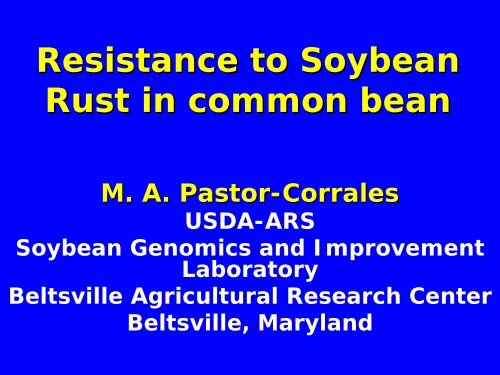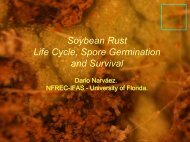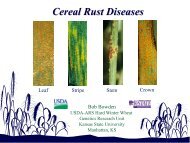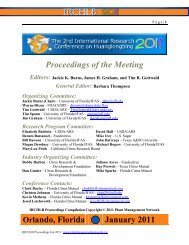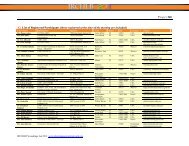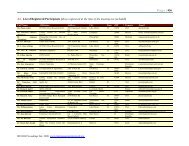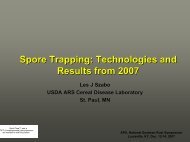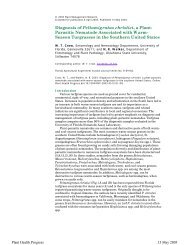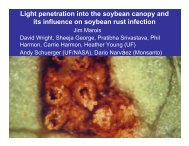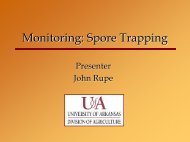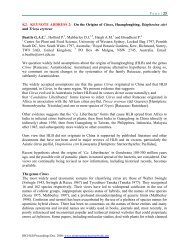Resistance to Soybean Rust in Dry Beans. - Plant Management ...
Resistance to Soybean Rust in Dry Beans. - Plant Management ...
Resistance to Soybean Rust in Dry Beans. - Plant Management ...
You also want an ePaper? Increase the reach of your titles
YUMPU automatically turns print PDFs into web optimized ePapers that Google loves.
<strong>Resistance</strong> <strong>to</strong> <strong>Soybean</strong><br />
<strong>Rust</strong> <strong>in</strong> common bean<br />
M. A. Pas<strong>to</strong>r-Corrales<br />
USDA-ARS<br />
<strong>Soybean</strong> Genomics and Improvement<br />
Labora<strong>to</strong>ry<br />
Beltsville Agricultural Research Center<br />
Beltsville, Maryland
Some Salient <strong>Soybean</strong><br />
Attributes <strong>Rust</strong><br />
of<br />
<strong>Soybean</strong> rust<br />
Moves swiftly<br />
A very aggressive plant pathogen<br />
Causes very severe yield losses and<br />
damage <strong>to</strong> soybean<br />
All commercial soybean cultivars<br />
are Susceptible<br />
Broad host range<br />
Potentially an important disease of<br />
other legum<strong>in</strong>ous crops
<strong>Soybean</strong> <strong>Rust</strong> Reports<br />
Japan 1902 Brazil 2002<br />
Australia 1934 Argent<strong>in</strong>a 2002<br />
Hawaii 1994 Bolivia 2003<br />
Uganda 1996 Uruguay 2004<br />
Zimbabwe 1998 USA 2004<br />
Nigeria 1999 Mexico 2005<br />
South Africa 2001 Ghana 2006<br />
Paraguay 2001 D.R. Congo 2007
Some Salient <strong>Soybean</strong><br />
Attributes <strong>Rust</strong><br />
of<br />
<strong>Soybean</strong> rust<br />
Moves swiftly<br />
A very aggressive plant pathogen<br />
Causes very severe yield losses and<br />
damage <strong>to</strong> soybean<br />
All commercial soybean cultivars<br />
are Susceptible<br />
Broad host range<br />
Potentially an important disease of<br />
other legum<strong>in</strong>ous crops
Premature defoliation of soybeans by<br />
<strong>Soybean</strong> <strong>Rust</strong> (Brazil)
Some Salient <strong>Soybean</strong><br />
Attributes <strong>Rust</strong><br />
of<br />
<strong>Soybean</strong> rust<br />
Moves swiftly<br />
A very aggressive plant pathogen<br />
Causes very severe yield losses and<br />
damage <strong>to</strong> soybean<br />
All commercial soybean cultivars<br />
are Susceptible<br />
Broad host range<br />
Potentially an important disease of<br />
other legum<strong>in</strong>ous crops
Hosts of <strong>Soybean</strong> <strong>Rust</strong><br />
LEGUMES (Papilionoideae)<br />
• Cultivated Crops:<br />
Glyc<strong>in</strong>e max (soybeans)<br />
Phaseolus vulgaris (<strong>Dry</strong> and Snap beans; e.i., i.e.., kidney beans)<br />
Phaseolus lunatus (lima and butter beans)<br />
Vigna unguiculata (cowpeas)<br />
Cajanus cajan (pigeon peas)<br />
Pachyrhizus erosus (yam bean, jicama)<br />
• Ornamental plants:<br />
Hyac<strong>in</strong>th bean, lup<strong>in</strong>e,<br />
royal po<strong>in</strong>ciana<br />
• Wild hosts:<br />
Kudzu, sweet clover
Some <strong>Soybean</strong> Salient Attributes <strong>Rust</strong> of<br />
<strong>Soybean</strong> rust<br />
Orig<strong>in</strong>ated <strong>in</strong> Asia<br />
Caused by Phakopsora pachyrhizi<br />
A very aggressive plant pathogen<br />
Moves swiftly<br />
Causes very severe yield losses and<br />
damage <strong>to</strong> soybean<br />
Broad host range<br />
Potentially an important disease<br />
of other legum<strong>in</strong>ous crops
SBR has been reported<br />
<strong>in</strong>fect<strong>in</strong>g common beans under<br />
field conditions<br />
• South Africa<br />
– <strong>Plant</strong> Disease, February 2005<br />
• United States<br />
– <strong>Plant</strong> Disease, July 2006<br />
• Argent<strong>in</strong>a<br />
– <strong>Plant</strong> Disease, January 2007<br />
• Brazil<br />
– Various reports, 2006, 2007
SBR - Symp<strong>to</strong>ms caused by<br />
Phakopsora pachyrhizi on<br />
Phaseolus vulgaris<br />
Bean rust symp<strong>to</strong>ms caused<br />
by Uromyces appendiculatus<br />
on Phaseolus vulgaris
The common bean<br />
(Phaseolus vulgaris)<br />
The most important legume for direct<br />
human consumption <strong>in</strong> the world<br />
Seed of dry beans<br />
Consumed as<br />
Pods of snap beans
Navy<br />
Dark Red Kidney
Study<strong>in</strong>g the differential<br />
Response of Common Bean <strong>to</strong><br />
SBR Isolates<br />
• Little <strong>in</strong>formation on the <strong>in</strong>teraction<br />
of <strong>in</strong>dividual isolates of P.<br />
pachyrhizi with common bean<br />
germplasm<br />
• 16 common bean cultivars<br />
challenged with six isolates of the<br />
SBR pathogen<br />
• Isolates were from Asia, Africa,<br />
Lat<strong>in</strong> America
Study<strong>in</strong>g the differential<br />
Response of Common Bean <strong>to</strong><br />
SBR Isolates<br />
• Little <strong>in</strong>formation on the <strong>in</strong>teraction<br />
of <strong>in</strong>dividual isolates of P.<br />
pachyrhizi with common bean<br />
germplasm<br />
• 16 common bean cultivars<br />
challenged with six isolates of the<br />
SBR pathogen<br />
• Isolates were from Asia, Africa,<br />
Lat<strong>in</strong> America
Study<strong>in</strong>g the differential<br />
Response of Common Bean <strong>to</strong><br />
SBR Isolates<br />
• Little <strong>in</strong>formation on the <strong>in</strong>teraction<br />
of <strong>in</strong>dividual isolates of P.<br />
pachyrhizi with common bean<br />
germplasm<br />
• 16 common bean cultivars<br />
challenged with six isolates of the<br />
SBR pathogen<br />
• Isolates were from Asia, Africa, Lat<strong>in</strong><br />
America
Differential Response of Common<br />
Bean Cultivars <strong>to</strong> SBR Isolates<br />
• Emphasis on beans with genes for<br />
resistance <strong>to</strong> the common bean<br />
rust Uromyces appendiculatus<br />
• Work was conducted under GH<br />
conditions <strong>in</strong> the USDA-ARS<br />
Foreign Disease-Weed Science<br />
Research Unit BSL-3 Conta<strong>in</strong>ment<br />
greenhouse at Ft. Detrick, MD
Differential Response of Common<br />
Bean Cultivars <strong>to</strong> SBR Isolates<br />
• Emphasis on beans with genes for<br />
resistance <strong>to</strong> the common bean<br />
rust Uromyces appendiculatus<br />
• Work was conducted under GH<br />
conditions <strong>in</strong> the USDA-ARS<br />
Foreign Disease-Weed Science<br />
Research Unit BSL-3 Conta<strong>in</strong>ment<br />
greenhouse at Ft. Detrick, MD
Bean cultivars <strong>in</strong>oculated with six<br />
Phakopsora pachyrhizi isolates<br />
Bean Cultivar Bean Type <strong>Resistance</strong> Gene<br />
P<strong>in</strong><strong>to</strong> 114 <strong>Dry</strong> bean None<br />
Aurora <strong>Dry</strong> bean Ur-3<br />
Early Gallat<strong>in</strong> Snap bean Ur-4<br />
Mexico 309 <strong>Dry</strong> bean Ur-5<br />
Golden White Wax Snap bean Ur-6<br />
PI 181996 <strong>Dry</strong> bean Ur-11<br />
CNC <strong>Dry</strong> bean Ur-C?, Ur-N?<br />
PI 260418 <strong>Dry</strong> bean Ur-P? ,Ur- I?
ARS bean germplasm l<strong>in</strong>es<br />
<strong>in</strong>oculated with six Phakopsora<br />
pachyrhizi isolates<br />
Bean Cultivar Bean Type <strong>Resistance</strong> Gene<br />
BelMiDak-RMR-10 <strong>Dry</strong> bean-ARS/Navy Ur-4, -11<br />
BelNeb-RR-1 <strong>Dry</strong> Bean – ARS/GN Ur-5, -6, -7<br />
BelMiNeb-RMR-5 <strong>Dry</strong> bean-ARS/GN Ur-4, -6, -11<br />
BelMiNeb-RMR-7 <strong>Dry</strong> bean-ARS/GN Ur-3, -4, -11<br />
BelDak-RR-2<br />
<strong>Dry</strong> bean-ARS/P<strong>in</strong><strong>to</strong> Ur-3, -6, CNN<br />
BelDakMi-RMR-14 <strong>Dry</strong> bean-ARS/P<strong>in</strong><strong>to</strong> Ur-3, -4, -11<br />
BelMiNeb-RMR-8 <strong>Dry</strong> bean-ARS/GN Ur-3, -4, -6, -11<br />
BelDakMi-RMR-18 <strong>Dry</strong> bean-ARS/P<strong>in</strong><strong>to</strong> Ur-3, -4, -6, -11
<strong>Soybean</strong> cultivars - Checks<br />
<strong>Soybean</strong><br />
Accession<br />
<strong>Resistance</strong><br />
genes<br />
PI 200492 (Komata) Rpp1<br />
PI 230970<br />
Rpp2<br />
Ina<br />
None; Mod. Susc.<br />
PI 459025B (B<strong>in</strong>g-Nan) Rpp4
Six Isolates of Phakopsora<br />
Pachyrhizi used <strong>in</strong> this<br />
study<br />
• TW72-1 Taiwan<br />
• TW80-2 Taiwan<br />
• TH01-1 Thailand<br />
• ZM01-1 Zimbabwe<br />
• BZ01-1 Brazil<br />
• PG01-2 Paraguay
<strong>Soybean</strong> <strong>Rust</strong>-<strong>Soybean</strong> Interactions<br />
Red Brown<br />
HR<br />
Necrotic spot<br />
Tan<br />
Susceptible
<strong>Soybean</strong> <strong>Rust</strong> Severity Scale<br />
1-5 Scale<br />
• 1 = No visible lesions<br />
• 2 = Few Scattered lesions present<br />
• 3 = Moderate number of lesions on<br />
at least part of the leaf<br />
• 4 = Abundant number of lesions on<br />
at least part of the leaf<br />
• 5 = Prolific lesion development over<br />
most of the leaf
<strong>Soybean</strong> <strong>Rust</strong> Sporulation Scale<br />
1-5 Scale<br />
• 1 = No sporulation<br />
• 2 = Present on but less than 25% of<br />
a fully sporulat<strong>in</strong>g lesion<br />
• 3 = Sporulation equal <strong>to</strong> 26 t0 50% of<br />
a fully sporulat<strong>in</strong>g lesion<br />
• 4 = Sporulation equal <strong>to</strong> 51 t0 75% of<br />
a fully sporulat<strong>in</strong>g lesion<br />
• 5 = Sporulation equal <strong>to</strong> a fully<br />
sporulat<strong>in</strong>g lesion
Differential Response of common<br />
bean <strong>to</strong> Phakopsora pachyrhizi<br />
• As a group, common cultivars<br />
appeared <strong>to</strong> have resistance <strong>to</strong><br />
SBR<br />
• None were immune<br />
• When compared with <strong>Soybean</strong><br />
cv. Ina, were similar <strong>in</strong> severity<br />
but had less sporulation
Differential Response of common<br />
bean <strong>to</strong> Phakopsora pachyrhizi<br />
• As a group, common cultivars<br />
appeared <strong>to</strong> have resistance <strong>to</strong><br />
SBR<br />
• None were immune<br />
• When compared with <strong>Soybean</strong><br />
cv. Ina, common bean cultivars<br />
were similar <strong>in</strong> severity but had<br />
less sporulation
Mean <strong>Soybean</strong> <strong>Rust</strong> severity and Sporulation of 16 common<br />
Bean Cultivars <strong>in</strong>oculated with six isolates of SBR pathogen<br />
_<br />
X=2.9<br />
_<br />
X=3.1<br />
_<br />
X=2.8<br />
_<br />
X=4.2
5.0<br />
4.5<br />
4.0<br />
3.5<br />
3.0<br />
2.5<br />
2.0<br />
1.5<br />
1.0<br />
Common bean cultivars Aurora,<br />
CNC, and PI 181996 had lower<br />
SBR severities than soybean Ina<br />
<strong>Soybean</strong> <strong>Rust</strong> Severity<br />
2.7 3.3<br />
2.9<br />
2.9 3.0 3.0 2.9 3.2 2.8 2.4 2.9 3.2 3.4 2.7 2.8 2.8<br />
3.1 3.1<br />
3.0<br />
3.5<br />
Aurora<br />
BDM-RMR-14<br />
BDM-RMR-18<br />
BelDak-RR-2<br />
BMD-RMR-10<br />
BMN-RMR-5<br />
BMN-RMR-7<br />
BMN-RMR-8<br />
BelNeb-RR-1<br />
CNC<br />
Early Gallat<strong>in</strong><br />
Golden W.W.<br />
Mexico 309<br />
PI 181996<br />
PI 260418<br />
P<strong>in</strong><strong>to</strong> 114<br />
Ina<br />
PI 200492<br />
PI 230970<br />
PI 459025B<br />
Common beans and <strong>Soybean</strong>s<br />
Mean severity
Common bean cultivars Aurora, CNC, PI<br />
181996, and P<strong>in</strong><strong>to</strong> 114 had significantly<br />
lower SBR sporulation than soybean Ina<br />
<strong>Soybean</strong> rust sporulation<br />
5.0<br />
4.5<br />
4.0<br />
3.5<br />
3.0<br />
2.5<br />
2.0<br />
1.5<br />
1.0<br />
2.3 4.2 3.6 2.4 3.4 3.7 2.8 3.7 2.7 3.3 4.8 4.8<br />
1. 6<br />
3.2 2.1 2.6 2.0 2.0<br />
3.0 3.5<br />
Aurora<br />
BDM-RMR-14<br />
BDM-RMR-18<br />
BelDak-RR-2<br />
BMD-RMR-10<br />
BMN-RMR-5<br />
BMN-RMR-7<br />
BMN-RMR-8<br />
BelNeb-RR-1<br />
CNC<br />
Early Gallat<strong>in</strong><br />
Golden W.W.<br />
Mexico 309<br />
PI 181996<br />
PI 260418<br />
P<strong>in</strong><strong>to</strong> 114<br />
Ina<br />
PI 200492<br />
PI 230970<br />
PI 459025B<br />
Common beans and soybeans<br />
Mean sporualation
Differential Response of Common<br />
Bean Cultivars <strong>to</strong> SBR Isolates<br />
• Cultivar-Isolate <strong>in</strong>teraction was<br />
significant<br />
• All common bean cultivars did not<br />
respond similarly <strong>to</strong> each SBR isolate<br />
for both, severity and sporualtion
Bean Cultivar - SBR Isolate<br />
Interaction<br />
Severity
Bean Cultivar - SBR Isolate Interaction<br />
Severity
Bean Cultivar - SBR<br />
Isolate Interaction<br />
Sporulation
Bean Cultivar - SBR Isolate Interaction<br />
Sporulation
Differential Response of<br />
Common Bean <strong>to</strong> SBR Isolates<br />
Summary<br />
• Bean cultivars CNC, PI<br />
181996, Aurora and P<strong>in</strong><strong>to</strong><br />
114 were the most resistant<br />
<strong>to</strong> all six isolates of SBR<br />
pathogen<br />
• These cultivars had lower<br />
severity, less sporulation,<br />
and consistent RB (resistant)<br />
lesions
Differential Response of<br />
Common Bean <strong>to</strong> SBR Isolates<br />
Summary<br />
• A differential response was observed<br />
among bean cultivars with a cultivarisolate<br />
<strong>in</strong>teraction for severity and<br />
sporulation<br />
• <strong>Resistance</strong> <strong>to</strong> SBR <strong>in</strong> common bean<br />
was <strong>in</strong>dependent of the resistance <strong>to</strong><br />
Uromyces appendiculatus<br />
• P<strong>in</strong><strong>to</strong> 114, universally susceptible <strong>to</strong><br />
U. appendiculatus – Resistant <strong>to</strong> SBR<br />
• BDM-RMR-18 with four genes for<br />
resistance <strong>to</strong> U. p. –one of the most<br />
susceptible <strong>to</strong> SBR
Inheritance of <strong>Resistance</strong> <strong>to</strong><br />
<strong>Soybean</strong> <strong>Rust</strong> <strong>in</strong> common bean<br />
Severity reaction <strong>to</strong><br />
Phakopsora pachyrhizi<br />
isolates<br />
BZ01-1 PG01-1 TH01-1 TW72-1 TW80-2 ZM01-1<br />
CNC 2.1 2.3 2.5 2.6 2.4 2.6<br />
Mex.<br />
309 3.7 3.7 3.0 3.4 3.4 3.4
4.0<br />
3.5<br />
3.0<br />
2.5<br />
2.0<br />
1.5<br />
CNC<br />
Mexico 309<br />
1.0<br />
0.5<br />
0.0<br />
BZ01-1 PG01-1 TH01-1 TW72-1 TW80-2 ZM01-1<br />
Reaction <strong>to</strong> Phakopsora pachyrhizi isolates<br />
<strong>Soybean</strong> <strong>Rust</strong> Severity Rat<strong>in</strong>g
Inheritance of <strong>Resistance</strong> <strong>to</strong><br />
<strong>Soybean</strong> <strong>Rust</strong> <strong>in</strong> common bean<br />
<strong>Soybean</strong> <strong>Rust</strong> Sporulation<br />
Sporulation <strong>to</strong> Phakopsora<br />
pachyrhizi isolates<br />
BZ01-<br />
1<br />
PG01-<br />
2<br />
TH01-<br />
1<br />
TW72-<br />
1<br />
TW80-<br />
1<br />
ZM01-<br />
1<br />
CNC 1.5 1.5 2.1 1.3 1.3 1.8<br />
Mex. 309 3.4 2.5 2.5 1.8 3.1 2.6
3.5<br />
3.0<br />
2.5<br />
2.0<br />
1.5<br />
CNC<br />
Mexico 309<br />
1.0<br />
0.5<br />
0.0<br />
BZ01-1 PG01-2 TH01-1 TW72-1 TW80-1 ZM01-1<br />
Reaction <strong>to</strong> Phakopsora pachyrhizi isolates
3.5<br />
3.0<br />
2.5<br />
2.0<br />
1.5<br />
CNC<br />
Mexico 309<br />
1.0<br />
0.5<br />
0.0<br />
BZ01-1 PG01-2 TH01-1 TW72-1 TW80-1 ZM01-1<br />
Reaction <strong>to</strong> Phakopsora pachyrhizi isolates
Inheritance of SBR resistance<br />
<strong>in</strong> common bean CNC<br />
• Cross: Mexico 309 (S) x CNC (R)<br />
• Two F 2 populations<br />
– P1: 117 F 2 plants<br />
– P2: 124 F 2 plants<br />
• All F 2 plants, R and S parents and<br />
soybean check <strong>in</strong>oculated with<br />
Brazilian isolate (BZ-1-1)
Total 117 124 241<br />
F 2<br />
Mexico 309 x CNC Phenotype based on Severity<br />
First batch Second batch Both Batches<br />
Grade # # #<br />
2 6 10 16<br />
3 63 61 124<br />
4 37 45 82<br />
5 11 8 19
Segregation for <strong>Resistance</strong> <strong>in</strong> CNC <strong>to</strong><br />
Phakopsora pachyrhizi (BZ01-1)<br />
Observed<br />
R S<br />
Expected<br />
Ratio χ P<br />
F 2<br />
140 101 9R:7S 0.01 0.9<br />
F 2<br />
140 101 3R:1S 13.6<br />
F 2<br />
140 101 13R:3S 45.3
<strong>Resistance</strong> <strong>in</strong> CNC <strong>to</strong> SBR<br />
• Results suggest that resistance <strong>in</strong> CNC is<br />
controlled by the <strong>in</strong>teraction of two genes<br />
• Complete dom<strong>in</strong>ance at both gene pairs<br />
• Either recessive homozygote is epistatic<br />
<strong>to</strong> the effects of the other gene<br />
• A_B_ = 9 Resistant<br />
• A_bb = 3 Susceptible<br />
• aaB_ = 3 Susceptible<br />
• Aabb = 1 Susceptible
<strong>Resistance</strong> <strong>in</strong> CNC <strong>to</strong> SBR<br />
• Results suggest that resistance <strong>in</strong> CNC is<br />
controlled by the <strong>in</strong>teraction of two genes<br />
• Complete dom<strong>in</strong>ance at both gene pairs<br />
• Either recessive homozygote is epistatic<br />
<strong>to</strong> the effects of the other gene<br />
• A_B_ = 9 Resistant<br />
• A_bb = 3 Susceptible<br />
• aaB_ = 3 Susceptible<br />
• Aabb = 1 Susceptible
Summary<br />
• Common beans appear <strong>to</strong> be much less<br />
susceptible <strong>to</strong> ASR than <strong>Soybean</strong>s<br />
• <strong>Resistance</strong> <strong>in</strong> common bean offers a number<br />
of opportunities for further studies with<br />
potential of lead<strong>in</strong>g <strong>to</strong> new genetic options<br />
for the control of the ASR pathogen<br />
• Further studies are needed <strong>to</strong> understand<br />
and characterize the resistance genes <strong>in</strong><br />
common bean <strong>to</strong> the ASR pathogen<br />
• Research should benefit dry and snap beans<br />
and possibly soybeans
Present and Future SRB Work<br />
• Search for molecular markers l<strong>in</strong>ked <strong>to</strong><br />
SBR resistance genes <strong>in</strong> CNC<br />
• Evaluate common bean core collection<br />
with selected isolates of SBR, <strong>in</strong>clude<br />
snap beans and commercial dry beans<br />
• Search for additional SBR resistance<br />
genes & possible vulnerabilities<br />
• If SBR resistance genes <strong>in</strong> common<br />
bean could be cloned - they could be<br />
used <strong>to</strong> genetically eng<strong>in</strong>eer soybeans<br />
with resistance <strong>to</strong> ASR
Glen<br />
Hartman<br />
Monte<br />
Miles<br />
Reid<br />
Frederick<br />
Morris<br />
Bonde


